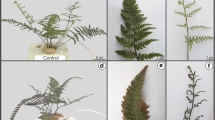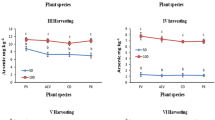Abstract
In field survey, Pteris vittata and Pityrogramma calomelanos were only found in arsenic (As) contaminated areas with soil pH 7.2–8.8 and 2.3–4.2, respectively. In the first pot experiment, two fern species were grown on the soil amended with 300 mg kg−1 As at soil pH of 5.1, 7.2 and 9. P. calomelanos survived all pH treatments, and had the highest frond As concentration and soil As removal efficiency at soil pH 5.1. All P. vittata plants were dead at soil pH 5.1. P. vittata had higher frond As concentration, biomass and the amount of As removed from the soil than those of P. calomelanos at soil pH of 7.2 and 9. In the second pot experiment, P. vittata was demonstrated to have greater life time, biomass, As tolerance and accumulation than those of P. calomelanos as planted on alkaline soil (pH 7.8) spiked with various concentrations of As.

Similar content being viewed by others
References
Anh BTK, Kim DD, Kuschk P, Tua TV, Hue NT, Minh NN (2013) Effect of soil pH on arsenic hyperaccumulation capacity in Pityrogramma calomelanos L. J Environ Biol 34:237–242
Carbonell-Barrachina AA, Aarabi MA, Delaune RD, Gambrell RP, Patrick, WHJr (1998) The influence of arsenic chemical form and concentration on Spartina patens and Spartina alterniflora growth and tissue arsenic concentration. Plant Soil 198:33–43
Carrier M, Loppinet-Serani A, Absalon C, Marias F, Aymonier C, Mench M (2011) Conversion of fern (Pteris vittata L.) biomass from a phytoremediation trial in sub- and supercritical water conditions. Biomass Bioenerg 35:872–883
Cox MS, Bell PE (1996) Differential tolerance of canola to arsenic when grown hydroponically or in soil. J Plant Nutr 19:1599–1610
Cullen WR, Reimer KJ (1989) Arsenic speciation in the environment. Chem Rev 89:713–764
Cunningham SD, Shann JR, Crowley DE, Anderson TA (1997) Phytoremediation of contaminated water and soil. In: Kruger EL, Anderson TA, Coats JR (eds) Phytoremediation of soil and water contaminants. ACS symposium series 664. American Chemical Society, Washington (DC), pp 2–19
Danh LT, Truong P, Mammucari R, Foster N (2014) A critical review of the arsenic uptake mechanisms and phytoremediation potential of Pteris vittata. Int J Phytoremed 16:429–453
Duc L, Trinh NCT, Dzung PV, Nhan NTT (2008) Arsenic compounds in soil contaminated by mining activities in Thai Nguyen province. Vietnam Soil Sci 30:87–105
Ha NT, Sakakibara M, Sano S, Nhuan MT (2011) Uptake of metals and metalloids by plants growing in a lead–zinc mine area, Northern Vietnam. J Hazard mater 186(2–3):1384–1391
Khan AG (2005) Role of soil microbes in the rhizospheres of plants growing on trace metal contaminated soils in phytoremediation. J Trace Elem Med Biol 18:355–364
Kukier U, Peters CA, Chaney RL, Angle JS, Roseberg RJ (2004) The effect of pH on metal accumulation in two species. J Environ Qual 33(6):2090–2102
Liao XY, Chen TB, Lei M, Huang ZC, Xiao XY, An ZZ (2004) Root distributions and elemental accumulations of Chinese brake (Pteris vittata L.) from As-contaminated soils. Plant Soil 261(1–2):109–116
Ma LQ, Komar KM, Tu C, Zhang W, Cai Y, Kennelley ED (2001) A fern that hyperaccumulates arsenic. Nature 409(6820):579–579
Niazi NK, Singh B, Van Zwieten L, Kachenko AG (2011) Phytoremediation potential of Pityrogramma calomelanos var. austroamericana and Pteris vittata L. grown at a highly variable arsenic contaminated site. Int J Phytorem 13(9):912–932
Niazi NK, Singh B, Van Zwieten L, Kachenko AG (2012) Phytoremediation of an arsenic-contaminated site using Pteris vittata L. and Pityrogramma calomelanos var. austroamericana: a long-term study. Environ Sci Pollut Res 19(8):3506–3515
Padmavathiamma PK, Li LY (2007) Phytoremediation technology: hyper-accumulation metals in plants. Water Air Soil Pollut 184:105–126
Ryan J, Estefan G, Rashid A (2007) Soil and plant analysis laboratory manual. ICARDA, Aleppo
Tu S, Ma LQ (2003) Interactive effects of pH, arsenic and phosphorus on uptake of As and P and growth of the arsenic hyperaccumulator Pteris vittata L. under hydroponic conditions. Environ Exp Bot 50(3):243–252
Tu S, Ma L, Luongo T (2004) Root exudates and arsenic accumulation in arsenic hyperaccumulating Pteris vittata and non-hyperaccumulating Nephrolepis exaltata. Plant Soil 258(1):9–19
Visoottiviseth P, Francesconi K, Sridokchan W (2002) The potential of Thai indigenous plant species for the phytoremediation of arsenic contaminated land. Environ Pollut 118:453–461
Yan XL, Chen TB, Liao XY, Huang ZC, Pan JR, Hu TD, Nie CJ, Xie H (2008) Arsenic transformation and volatilization during incineration of the hyperaccumulator Pteris vittata L. Environ Sci Technol 42:1479–1484
Yong JW, Tan SN, Ng YF, Low KK, Peh SF, Chua JC, Lim AA (2010) Arsenic hyperaccumulation by Pteris vittata and Pityrogramma calomelanos: a comparative study of uptake efficiency in arsenic-treated soils and waters. Water Sci Technol 61(12):3041–3049
Zhao FJ, Dunham SJ, McGrath SP (2002) Arsenic hyperaccumulation by different fern species. New Phytol 156:27–31
Acknowledgements
This research was funded by the National Foundation for Science and Technology Development of Vietnam (NAFOSTED) under Grant Number 105.08-2014.12.
Author information
Authors and Affiliations
Corresponding author
Rights and permissions
About this article
Cite this article
Anh, B.T.K., Minh, N.N., Ha, N.T.H. et al. Field Survey and Comparative Study of Pteris Vittata and Pityrogramma Calomelanos Grown on Arsenic Contaminated Lands with Different Soil pH. Bull Environ Contam Toxicol 100, 720–726 (2018). https://doi.org/10.1007/s00128-018-2325-5
Received:
Accepted:
Published:
Issue Date:
DOI: https://doi.org/10.1007/s00128-018-2325-5




